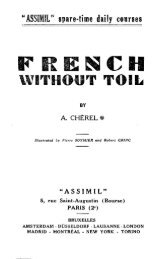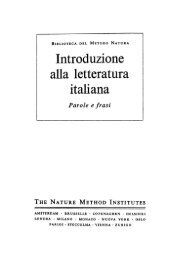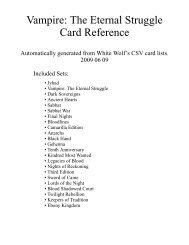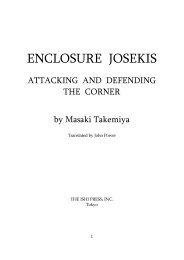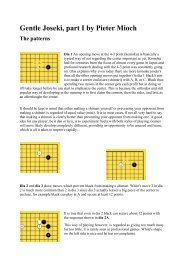Plains Cree: A Grammatical Study - Computer Science Club
Plains Cree: A Grammatical Study - Computer Science Club
Plains Cree: A Grammatical Study - Computer Science Club
Create successful ePaper yourself
Turn your PDF publications into a flip-book with our unique Google optimized e-Paper software.
30 [TRANS. AMER. PHIL. SOC.<br />
mihko 'blood' (stem mihkw-).45 A form like kona<br />
'snow' shows that the retention of the final vowel is<br />
not restricted to monosyllabic stems with a short<br />
vowel (cf. appendix A: 5.1).<br />
3.311. The addition of a prefix does not affect the<br />
retention of the suffixal vowel, e.g., otosi 'his canoe'<br />
or omihko 'his blood.' One interpretation of these<br />
forms would require apocope of the suffixal vowel<br />
to precede the addition of the prefix (both synchronic-<br />
ally and historically); this would conflict with the<br />
fact that the affixes of the possession paradigm are<br />
closer to the stem than those of the number-obviation<br />
paradigm, e.g., kitosinaw 'our canoe.' It seems more<br />
likely that monosyllabic stems without possessive<br />
suffixes are exempt from the apocope rule due to the<br />
pattern pressure of the simple forms; in fact, the<br />
historical sources show some fluctuation. Clearly,<br />
the whole issue of monosyllabic stems requires<br />
further investigation.<br />
The suffixal vowel of monosyllabic stems is retained<br />
even when they function as the second member of a<br />
compound, e.g., wdkayosi-wdti 'bear den'; this is<br />
seen as evidence of the independent phonological<br />
status of compound members (cj. 6.5).<br />
3.312. Phonemically, the proximate singular and<br />
the obviative of monosyllabic animate stems are<br />
homophonous. Occasionally, this homophony is re-<br />
solved by the addition of another -wa to the obviative<br />
form ending in -wa. Thus, in T523p47, 48, 49 we find<br />
both maskwa and maskwawa as the obviative of<br />
maskwa 'bear.' An extra -wa suffix also occurs in the<br />
obviative of certain other words most of which are<br />
46 The following list of monosyllabic noun stems appears to be<br />
relatively complete:<br />
Animate:<br />
-4w- 'wife' (dependent stem)<br />
-Iskw- 'fellow wife' (dependent stem)<br />
cts- 'Cisa' (name of trickster)<br />
es- 'clam-shell'<br />
ihkw- 'louse'<br />
kakw- 'porcupine'<br />
kon- 'snow'<br />
maskw- 'bear'<br />
mdkw-, mwakw- 'loon'<br />
mosw- 'moose'<br />
nisk- 'goose'<br />
piskw- 'mosquito-hawk'<br />
siht- 'evergreen'<br />
Inanimate:<br />
-ik-<br />
mey-<br />
mihkw-<br />
miht-<br />
6s-<br />
pihkw-<br />
wdt-<br />
waw-<br />
wlkw-<br />
win-<br />
wls-<br />
wust-<br />
'dwelling' (dependent stem)<br />
'dung'<br />
'blood'<br />
'firewood'<br />
'canoe'<br />
'ashes'<br />
'hole'<br />
'egg'<br />
'kidney-fat'<br />
'marrow'<br />
'belly-fat'<br />
'beaver-lodge'<br />
WOLFART: PLAINS CREE<br />
clearly loans from English, e.g., omamawa 'his mother,'<br />
from nimdma; meriwa 'Mary' from meriy; cimiwa<br />
'Jimmy' from cimiy, etc.<br />
3.32. /w/- Alternation<br />
The number-obviation ("third person") suffixes of<br />
nouns appear with two sets of alternants. One has<br />
initial /w/, namely /wa, wi, wah/, the other lacks it,<br />
namely /a, i, ah/.<br />
Generally, the distribution of the alternants is<br />
governed by the preceding environment; after a<br />
consonant the /w/-less alternant occurs, after a vowel<br />
that with /w/.<br />
For instance, consider the forms<br />
nitemak 'my horses,' otema 'his horse,' etc., but<br />
otemiyiwa 'his (3') horse.' Cf. 5.471 for the similar<br />
situation in the transitive animate verb paradigm.<br />
A large number of noun stems end in a cluster<br />
/Cw/. Since the /w/ occurs not only in the 3 and 3p<br />
forms but in the 3' form and in the locative or vocative<br />
forms as well, the /w/ clearly belongs to the stem<br />
and does not take part in any alternation; the deri-<br />
vational structure of the stem does not bear on the<br />
problem at hand. Thus, mistikw-: mistik 'tree,'<br />
mistikwak 'trees'; with suffix /eyiwa/: omistikoyiwa<br />
'his (3') tree'; with suffix /ehk/: mistikohk 'on a tree';<br />
or consider the stem atimw-: atim 'dog,' atimwak<br />
'dogs'; with suffix /etik/: atimotik 'you dogs!'<br />
In nouns ending in /Vw/, the identification of the<br />
/w/ is less clear-cut.46 Consider the noun ndpew<br />
'man' whose other inflected forms are ndpewak and<br />
ndpewa; its stem could be set up as either ndpe- or<br />
ndpew-. The formation of the possessed theme fails<br />
to throw light on the problem because ninapem might<br />
be formed from either stem; the contraction of<br />
/ew-e/ to /e/ occurs independently, e.g., in the<br />
inflection of the verb stem wicew- 'have him along':<br />
niwicek 'he has me along,' kiwicetin 'I have you<br />
along,' etc.; cf. appendix A: 4.2. The relevant mor-<br />
phophonological statements are all independently<br />
motivated and thus do not indicate a solution.<br />
The existence of parallel stems in /Vy/, e.g., askiy<br />
'land,' apasoy 'tent-pole,' supports the analysis of the<br />
semivowel as part of the stem. But the evidence is<br />
not conclusive, and a full treatment of noun stems<br />
ending in a vowel-semivowel sequence will have to<br />
await further synchronic and comparative studies.<br />
3.4. PARADIGM TABLES<br />
The tables show the possessive and number-<br />
obviation paradigms combined. For an explanation<br />
of the blank positions in the first table see 3.2 and 2.21.<br />
The paradigms are given in phonemic representa-<br />
tion; cf. Appendix A, especially fn. 85.<br />
46A parallel situation exists in Menomini where there are at<br />
least two derivational morphemes /w/ one of which "is homony-<br />
mous with inflectional -3w and demands the same replacements<br />
of preceding vowels" (Bloomfield, 1962: p. 242).



